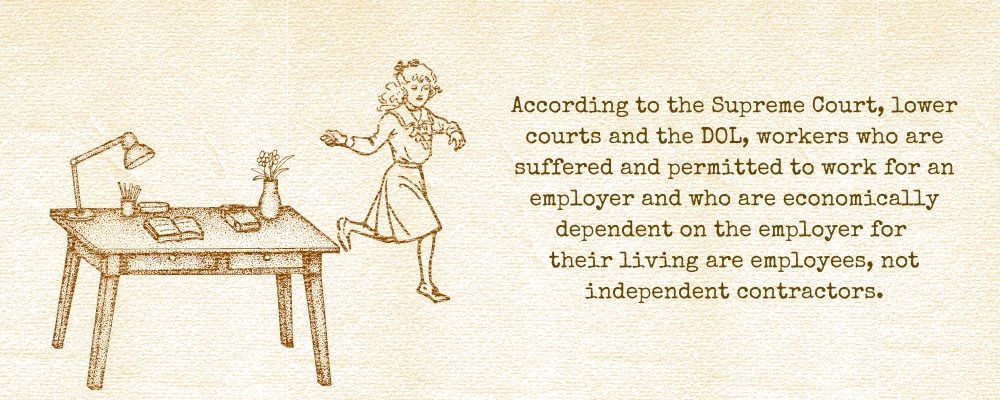DOL proposes new rule to define independent contractor status
The Department of Labor has issues a proposed rule seeking to tease out the difference between employees and independent contractors for purposes of the Fair Labor Standards Act. The proposed rule has not yet been published in the Federal Register and won’t become effective until a final rule is issued.
If finalized, the rule would “adopt general interpretations to which courts and the Department [of Labor] have long adhered.”

What the law is now
The FLSA has never defined the terms employees and independent contractors. The U.S. Supreme Court did, way back in 1947, a mere nine years after the FLSA was enacted. According to the Supreme Court, lower courts and the DOL, workers who are suffered and permitted to work for an employer and who are economically dependent on the employer for their living are employees, not independent contractors.
Over the years, this has been distilled into a six-part, economic reality or economic dependence test, where no factor is more important than any other:
- The extent to which the services rendered are an integral part of the employer’s business.
- The permanency of the relationship between the employer and the worker.
- The amount of the worker’s investment in facilities and equipment.
- The nature and degree of control asserted over the worker by the employer.
- The worker’s opportunity for profit and loss.
- The amount of initiative, judgment or foresight in open-market competition with others required for the worker’s success.
The linchpin, of course, is control.
Total economic dependence isn’t required. If the requisite level of control is present, workers will be considered employees, if they depend on an employer for continued employment in that line of business. Typically, courts say workers don’t have to be totally dependent on an employer for their living or even have the employer as their primary source of income for them to be considered employees.
Proposed rule
Under the proposed rule, how workers and employers actually interact is more important than what may be contractually or theoretically possible. This is sort of like what the IRS says—labeling a worker as an independent contractor won’t stand up if, in reality, the worker is an employee.
Instead of the traditional six-factor test, the DOL proposes to use five distinct factors. Under the proposed rule, two core factors—the nature and degree of the worker’s control over the work (e.g., setting work hours and selecting projects) and the worker’s opportunity for profit or loss—would get to the heart of economic dependence or independence, and would, therefore, be afforded greater weight than the other factors.
If a worker’s status still isn’t clear after applying those two core factors, three other factors may serve as additional guideposts:
- The amount of skill required for the work. Employee: The work requires no specialized training or skill and the employer provides tools. Independent contractor: The work requires specialized training or skill the potential employer doesn’t possess.
- The degree of permanence of the working relationship between the worker and the potential employer. Employee: The work relationship is indefinite or continuous. Independent contractor: The work relationship is by design definite in duration or sporadic.
- Whether the work is part of an integrated unit of production. Employee: The work is a component of the potential employer’s integrated process for producing a good or service. Independent contractor: The work is segregable from the potential employer’s production process.

Whose core is it?
The rule seems to take aim at gig workers, like drivers for Uber and Lyft. According to the proposed rule, the core requirement of the worker’s control over the work would seem to apply to the worker. The DOL, in the rule’s preamble, however, seems to apply this requirement to the potential employer. According to the DOL, Uber’s core business, for example, isn’t hiring drivers, but operating a technology platform.
We’ve seen this before, in state laws—Indiana (tax, unemployment, wage-and-hour and wage-payment laws), Kentucky (tax, unemployment, wage-and-hour and wage-payment laws), Tennessee (unemployment laws) and Utah (wage-payment laws).
Not as easy as ABC
Even if this rule were to become final, it probably wouldn’t change the gig worker/employee dispute much. By and large, gig workers are suing potential employers under state unemployment, wage-and-hour and/or wage-payment laws, which use a much looser test, called the ABC test.
Under the ABC test, workers are considered employees, unless you can prove the following three things:
- A: Employees are free from control in connection with the performance of their services.
- B: Their services are performed outside the usual course of the employer’s business or outside of all the places of the employer’s business.
- C: Employees are customarily engaged in an independently established trade or business.
Care to comment?
The DOL will take comments for 30 days after the rule is published in the Federal Register. Since we don’t yet know when that will be, it’s a good idea to get your comments in as soon as possible.
Identify your comments by Regulatory Information Number (RIN) 1235-AA34.






